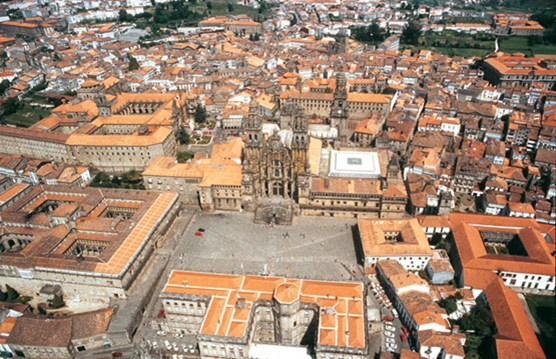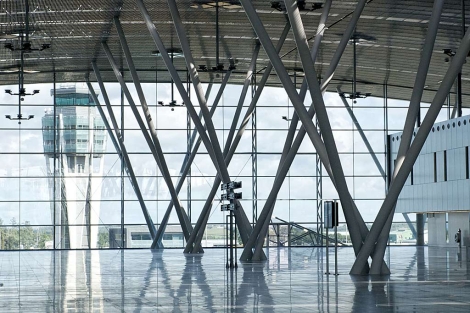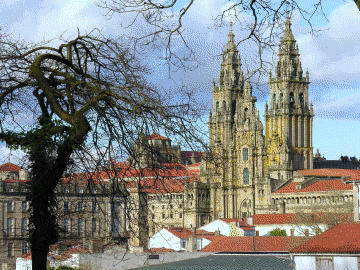The city of Santiago de Compostela
 Description
Description
Santiago de Compostela is the capital of the autonomous community of Galicia, with a population of around 95,671 inhabitants and a metropolitan area of 178,695.
As the home of the autonomous government of Galicia and of one of the oldest universities in Europe, Santiago’s economy is still heavily dependent on public services, cultural and tourism industry and higher education, although in recent years it has become increasingly diversified. New industries such as timber transformation, the automotive industry, and telecommunications and electronics have been established.
In 1985 the city's Old Town was designated a UNESCO World Heritage Site.
The population of the city in 2012 was 95,671 inhabitants, while the metropolitan area reaches 178,695.
(Adapted from: http://en.wikipedia.org/wiki/Santiago_de_Compostela)
Galicia is an autonomous community in northwest Spain, with the official status of a nationality. It is bordered by Portugal to the south, the Spanish autonomous communities of Castile and León and Asturias to the east, the Atlantic Ocean to the west, and the Bay of Biscay to the north. It has a population of about 2,778,913.
Galicia has two official languages which are widely used, the native Galician, a Romance language closely related to Portuguese with which it shares a common Galician-Portuguese medieval literature, and Spanish, usually known locally as Castilian. 56.4% of the Galician population always speaks in Galician or speaks more in Galician than in Castilian, while 42.5% speaks always in Castilian or more in Castilian than in Galician.
(Adapted from http://en.wikipedia.org/wiki/Galicia_(Spain))
How to get here
 Santiago de Compostela is located near the geographical centre of Galicia, Spain 's northern- and westernmost region. Its International Lavacolla Airport connects the city by plane with direct flights from the main Spanish cities (Alicante, Barcelona, Bilbao, Madrid, Málaga, Palma de Mallorca, Sevilla, Valencia) as well as other European airports (Dublin (DUB), Frankfurt (HHN), London (STN), London (LGW), Paris (CDG), Milan (BGY), Zurich (ZRH), Geneva (GVA), Basel (BSL), Istambul (IST).
Santiago de Compostela is located near the geographical centre of Galicia, Spain 's northern- and westernmost region. Its International Lavacolla Airport connects the city by plane with direct flights from the main Spanish cities (Alicante, Barcelona, Bilbao, Madrid, Málaga, Palma de Mallorca, Sevilla, Valencia) as well as other European airports (Dublin (DUB), Frankfurt (HHN), London (STN), London (LGW), Paris (CDG), Milan (BGY), Zurich (ZRH), Geneva (GVA), Basel (BSL), Istambul (IST).
Although it may take some more time, the city can also be reached by train or bus from other Spanish cities and some European destinations.
You can come on foot as well, following the Way of St. James, but in this case it will definitely take you much, much longer!
For further information please visit the website http://www.santiagoturismo.com/como-chegar.
For further information on how to get from the airport to the city centre, please visit the website http://www.empresafreire.com/html/ingles/seccion0.php.
Tourist information
Santiago de Compostela is a city full of charm and mysticism. You will be definitely impressed by its breathtaking cathedral, its ancient monuments and contemporary architecture together with its traditional and modern museums. Its parks and gardens are also the perfect lounge to contemplate Compostela's sunsets.
If you want to learn more about what to see, what to do, the pilgrimage routes of St James and many other interesting things, please visit Santiago de Compostela's Official Tourism Web www.santiagoturismo.com.
If you are interested in popular festivals of tourist interest, Galicia is well-known for some colourful Carnival celebrations that take place in February/March in villages not very far from Santiago. For further information, please visit: www.turgalicia.es.
Galicia and its Atlantic cuisine
 Gastronomy is one of Galicia’s main attractions: the quality and variety of local produce, the lasting traditions and evolution while respecting the past form the basis of Galician cuisine. Local products, whether crops or livestock or, especially, from the sea, have their own special characteristics and are cooked in ways that are traditional and thoughtful, home-made, unhurried, plentiful and varied, giving rise to a special, highly-renowned and much-appreciated cuisine.
Gastronomy is one of Galicia’s main attractions: the quality and variety of local produce, the lasting traditions and evolution while respecting the past form the basis of Galician cuisine. Local products, whether crops or livestock or, especially, from the sea, have their own special characteristics and are cooked in ways that are traditional and thoughtful, home-made, unhurried, plentiful and varied, giving rise to a special, highly-renowned and much-appreciated cuisine.
You cannot miss the seafood: barnacles, spider crabs, crabs, lobsters... The clams and mussels are delicious. And the fish stews are unbeatable. Inland, the octopus, empanadas (pies), stew and pork shoulder with turnip tops are a must. The region is also well-known for its outstanding wines and liquors.
For further information on gastronomy and wine routes, please click here, here and here.
Climate
Santiago de Compostela has a humid oceanic climate, with drier summers, which guarantees mild temperatures throughout the year. The prevailing winds from the Atlantic and the surrounding mountains combine to give Santiago some of Spain’s highest rainfall: about 1,545 millimetres annually. The climate is mild: frosts are common only in December, January and February, with an average of just 8 days per year, while it rarely snows more than once or twice a year. The annual mean temperature is around 15 ºC, with an average of 8 ºC in winter and a pleasant summer with temperatures ranging from 20 to 27 ºC. Temperatures under -1ºC or over 35 °C are exceptional.
Source: www.climatedata.eu
If you wish to check the weather forecast you can visit this website.
Interesting links
http://en.wikipedia.org/wiki/Santiago_de_Compostela
http://en.wikipedia.org/wiki/Galicia_(Spain)
http://www.santiagoturismo.com/
http://www.santiagodecompostela.org
http://www.compostelacapitalcultural.com
http://en.wikipedia.org/wiki/Way_of_St._James
http://www.guardian.co.uk/spanish-tourist-board/santiago-de-compostela-spain-galicia
http://www.theage.com.au/travel/walk-pray-then-feast-20120504-1y33f.html




